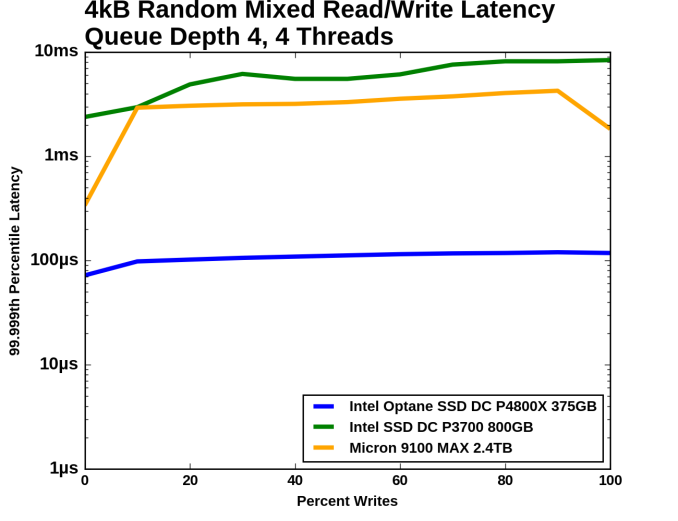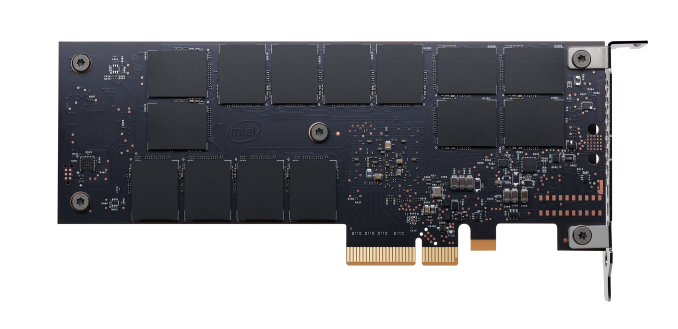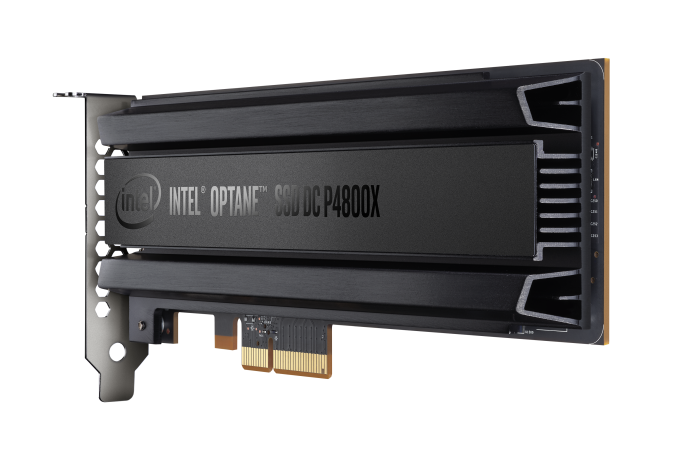The Intel Optane SSD DC P4800X (375GB) Review: Testing 3D XPoint Performance
by Billy Tallis on April 20, 2017 12:00 PM ESTFinal Words: Is 3D XPoint Ready?
The Intel Optane SSD DC P4800X is a very high-performing enterprise SSD, but more importantly it is the first shipping product using Intel's 3D XPoint memory technology. After a year and a half of talking up 3D XPoint, Intel has finally shipped something. The P4800X proves that 3D XPoint memory is real and that it really works. The P4800X is just a first-generation product, but it's more than sufficient to establish 3D XPoint memory as a serious contender in the storage market.
If your workload matches its strengths, the P4800X offers performance that cannot currently be provided by any other storage product. This means high throughput random access, as well as very strict latency requirements - the results Optane achieves for it's quality of service for latency on both reads and writes, especially in heavy environments with a mixed read/write workload, is a significant margin ahead of anything available on the market.

At 50/50 reads/writes, latency QoS for the DC P4800X is 30x better than the competition
The Intel Optane SSD DC P4800X is not the fastest SSD ever on every single test. It's based on a revolutionary technology, but no matter how high expectations were, very rarely does a first-generation product take over the world unless it becomes ubiquitous and cheap on day one. The Optane SSD is ultimately an expensive niche product. If you don't need high throughput random access with the strictest latency requirements, the Optane SSD DC P4800X may not be the best choice. It is very expensive compared to most flash-based SSDs.
With the Optane SSD and 3D XPoint memory now clearly established as useful and usable, the big question is how broad its appeal will be. The originally announcements around Optane promised a lot, and this initial product delivers a few of those metrics, so to some extent, the P4800X may have to grow its own market and reteach partners what Optane is capable of today. Working with developers and partners is going to be key here - they have to perform outreach and entice software developers to write applications that rely on extremely fast storage. That being said, there are plenty of market segments already that can never get enough storage performance, so anything above what is available in the market today will be more than welcome.
There's still much more we would like to know about the Optane SSD and the 3D XPoint memory it contains. Since our testing was remote, we have not yet even had the chance to look under the drives's heatsink, or measure the power efficiency of the Optane SSD and compare it against other SSDs. We are awaiting an opportunity to get a drive in hand, and expect some of the secrets under the hood to be exposed in due course as drives filter through the ecosystem.












117 Comments
View All Comments
Ninhalem - Thursday, April 20, 2017 - link
At last, this is the start of transitioning from hard drive/memory to just memory.ATC9001 - Thursday, April 20, 2017 - link
This is still significantly slower than RAM....maybe for some typical consumer workloads it can take over as an all in one storage solution, but for servers and power users, we'll still need RAM as we know it today...and the fastest "RAM" if you will is on die L1 cache...which has physical limits to it's speed and size based on speed of light!I can see SSD's going away depending on manufacturing costs but so many computers are shipping with spinning disks still I'd say it's well over a decade before we see SSD's become the replacement for all spinning disk consumer products.
Intel is pricing this right between SSD's and RAM which makes sense, I just hope this will help the industry start to drive down prices of SSD's!
DanNeely - Thursday, April 20, 2017 - link
Estimates from about 2 years back had the cost/GB price of SSDs undercutting that of HDDs in the early 2020's. AFAIK those were business as usual projections, but I wouldn't be surprised to see it happen a bit sooner as HDD makers pull the plug on R&D for the generation that would otherwise be overtaken due to sales projections falling below the minimums needed to justify the cost of bringing it to market with its useful lifespan cut significantly short.Guspaz - Saturday, April 22, 2017 - link
Hard drive storage cost has not changed significantly in at least half a decade, while ssd prices have continued to fall (albeit at a much slower rate than in the past). This bodes well for the crossover.Santoval - Tuesday, June 6, 2017 - link
Actually it has, unless you regard HDDs with double density at the same price every 2 - 2.5 years as not an actual falling cost. $ per GB is what matters, and that is falling steadily, for both HDDs and SSDs (although the latter have lately spiked in price due to flash shortage).bcronce - Thursday, April 20, 2017 - link
The latency specs include PCIe and controller overhead. Get rid of those by dropping this memory in a DIMM slot and it'll be much faster. Still not as fast as current memory, but it's going to be getting close. Normal system memory is in the range of 0.5us. 60us is getting very close.tuxRoller - Friday, April 21, 2017 - link
They also include context switching, isr (pretty board specific), and block layer abstraction overheads.ddriver - Friday, April 21, 2017 - link
PCIE latency is below 1 us. I don't see how subtracting less than 1 from 60 gets you anywhere near 0.5.All in all, if you want the best value for your money and the best performance, that money is better spent on 128 gigs of ecc memory.
Sure, xpoint is non volatile, but so what? It is not like servers run on the grid and reboot every time the power flickers LOL. Servers have at the very least several minutes of backup power before they shut down, which is more than enough to flush memory.
Despite intel's BS PR claims, this thing is tremendously slower than RAM, meaning that if you use it for working memory, it will massacre your performance. Also, working memory is much more write intensive, so you are looking at your money investment crapping out potentially in a matter of months. Whereas RAM will be much, much faster and work for years.
4 fast NVME SSDs will give you like 12 GB\s bandwidth, meaning that in the case of an imminent shutdown, you can flush and restore the entire content of those 128 gigs of ram in like 10 seconds or less. Totally acceptable trade-back for tremendously better performance and endurance.
There is only one single, very narrow niche where this purchase could make sense. Database usage, for databases with frequent low queue access. This is an extremely rare and atypical application scenario, probably less than 1/1000 in server use. Which is why this review doesn't feature any actual real life workloads, because it is impossible to make this product look good in anything other than synthetic benches. Especially if used as working memory rather than storage.
IntelUser2000 - Friday, April 21, 2017 - link
ddriver: Do you work for the memory industry? Or hold a stock in them? You have a personal gripe about the company that goes beyond logic.PCI Express latency is far higher than 1us. There are unavoidable costs of implementing a controller on the interface and there's also software related latency.
ddriver - Friday, April 21, 2017 - link
I have a personal gripe with lying. Which is what intel has been doing every since it announced hypetane. If you find having a problem with lying a problem with logic, I'd say logic ain't your strong point.Lying is also what you do. PCIE latency is around 0.5 us. We are talking PHY here. Controller and software overhead affect equally every communication protocol.
Xpoint will see only minuscule latency improvements from moving to dram slots. Even if PCIE has about 10 times the latency of dram, we are still talking ns, while xpoint is far slower in the realm of us. And it ain't no dram either, so the actual latency improvement will be nowhere nearly the approx 450 us.
It *could* however see significant bandwidth improvements, as the dram interface is much wider, however that will require significantly increased level of parallelism and a controller that can handle it, and clearly, the current one cannot even saturate a pcie x4 link. More bandwidth could help mitigate the high latency by masking it through buffering, but it will still come nowhere near to replacing dram without a tremendous performance hit.